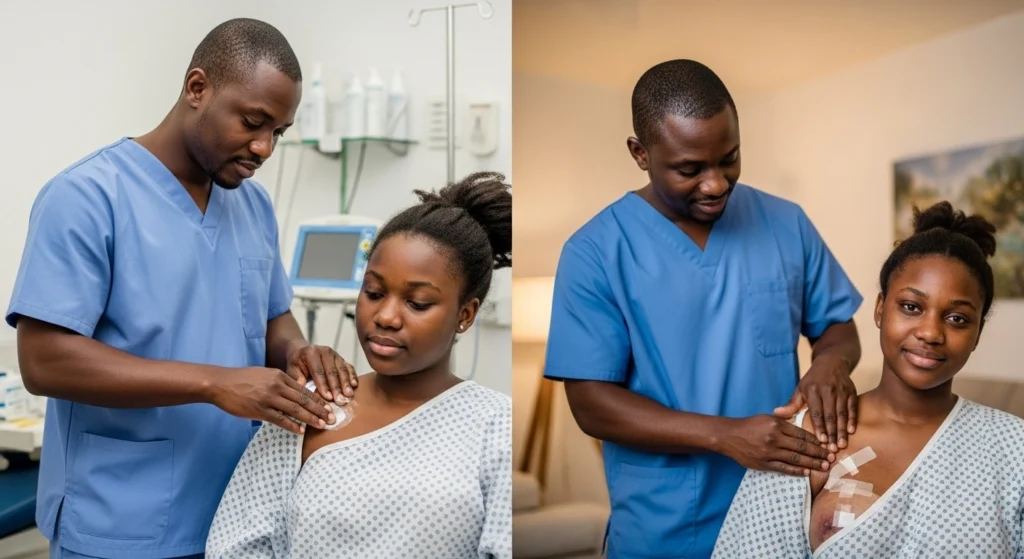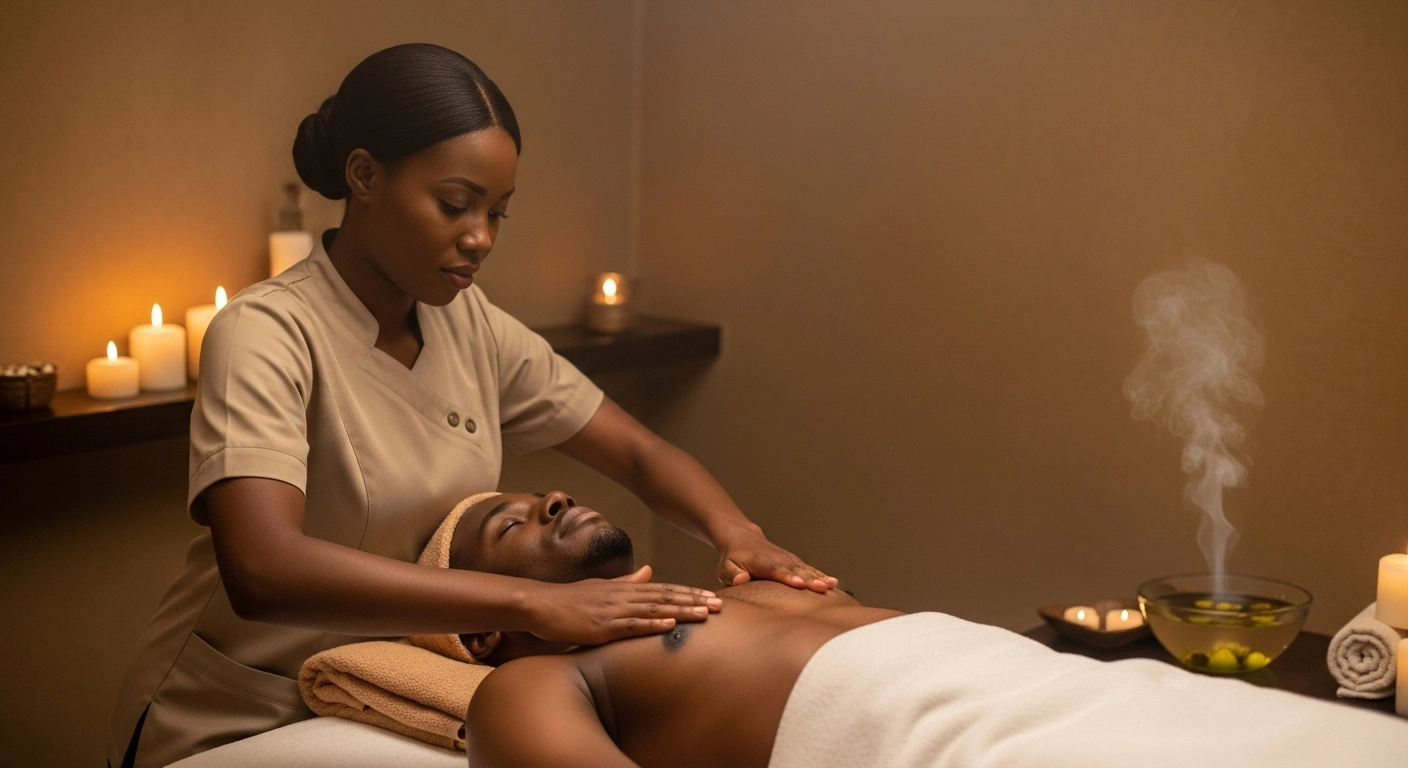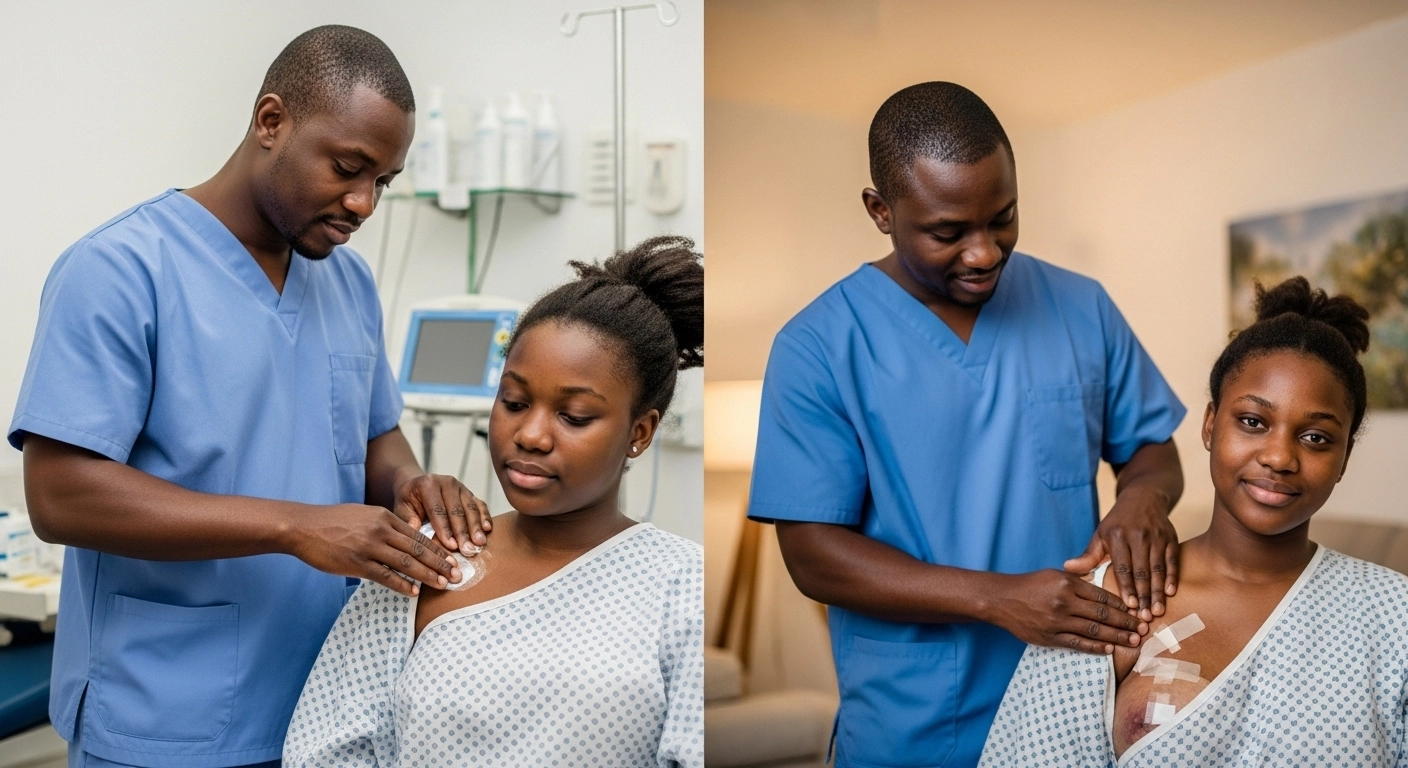If you’re facing breast surgery or recovering from a procedure, you’re likely feeling overwhelmed by questions about healing, pain management, and getting back to normal function. Many women don’t realize that the recovery process can be significantly impacted by complications like lymphedema, scar tissue formation, limited range of motion, and persistent pain that affects their quality of life for months or even years after surgery. The medical system often focuses on the surgical procedure itself but provides limited guidance on optimizing healing and preventing long-term complications through complementary therapies. You might be wondering what you can do beyond following basic post-surgical instructions to ensure the best possible outcome and fastest, most complete recovery.
The encouraging truth is that therapeutic breast massage can play a transformative role in both pre-surgical preparation and post-surgical recovery, offering evidence-based benefits that can dramatically improve your surgical experience and long-term outcomes. At Lebien etre, we’ve witnessed remarkable improvements in surgical recovery when clients incorporate professional massage therapy into their treatment plan, working in coordination with their medical teams. Pre-surgical massage can optimize tissue health, reduce anxiety, and prepare your body for the healing process, while post-surgical massage can prevent complications, reduce scar tissue formation, restore function, and accelerate recovery. Understanding how therapeutic massage integrates with surgical care empowers you to take an active role in your healing journey and achieve the best possible results from your procedure.
Pre-Surgical Massage: Preparing Your Body for Optimal Healing
Tissue Preparation and Optimization
Pre-surgical massage focuses on optimizing the health and flexibility of tissues that will be affected by the procedure, creating the best possible conditions for surgical success and healing. Enhanced circulation through targeted massage brings increased oxygen and nutrients to the area while helping remove metabolic waste products that could impair healing. This tissue conditioning can reduce surgical complications and improve the body’s ability to respond positively to the procedure.
Lymphatic preparation is particularly important before breast surgery, as the lymphatic system will be disrupted during most procedures. Pre-surgical lymphatic massage helps establish optimal flow patterns and can reduce the risk of developing lymphedema after surgery.
Scar tissue prevention begins before surgery through massage techniques that maintain tissue mobility and prevent existing restrictions from complicating the surgical procedure or healing process. Healthy, flexible tissues respond better to surgical intervention and heal more predictably.
The improved tissue quality achieved through pre-surgical massage can lead to better surgical outcomes, reduced complications, and faster healing times, making it a valuable investment in your surgical success.
Stress Reduction and Immune Support
Surgical anxiety is a significant factor that can negatively impact healing, immune function, and recovery outcomes. Pre-surgical massage provides measurable stress reduction benefits, including decreased cortisol levels and improved emotional well-being that supports the body’s natural healing processes.
Immune system optimization through massage therapy helps ensure that your body’s defense mechanisms are functioning at their best when you need them most. Studies show that massage can increase white blood cell activity and improve immune markers that are crucial for post-surgical healing.
Sleep quality improvement before surgery is another important benefit of pre-surgical massage, as adequate rest is essential for immune function and healing preparation. Many clients report better sleep patterns and reduced pre-surgical anxiety after beginning massage therapy.
The mind-body connection supported through therapeutic massage helps create a positive mindset and emotional resilience that can significantly impact surgical recovery and overall healing experience.
Range of Motion and Functional Preparation
Baseline mobility assessment and improvement through pre-surgical massage helps establish optimal function before surgery, making post-surgical rehabilitation more effective. Maintaining or improving range of motion before surgery provides a better starting point for recovery.
Compensatory pattern prevention involves addressing existing tension or movement dysfunctions that could be exacerbated by surgical positioning or post-surgical restrictions. Pre-surgical massage can prevent these secondary complications from developing.
Postural optimization through targeted massage and education helps prepare your body for the temporary movement limitations and positioning changes that occur after breast surgery. Better pre-surgical posture can reduce post-surgical pain and complications.
Understanding the importance of functional preparation helps clients approach surgery with confidence and realistic expectations about their recovery process and timeline.
Post-Surgical Recovery Applications
Immediate Post-Operative Care (0-6 Weeks)
Early intervention in the immediate post-surgical period focuses on gentle techniques that support healing without interfering with the surgical site. Professional therapists trained in post-surgical care understand the timeline and restrictions that apply to different types of breast surgery procedures.
Lymphatic drainage becomes crucial immediately after surgery to prevent fluid accumulation and reduce swelling that can impair healing and increase discomfort. Gentle lymphatic massage techniques can be safely applied even in the early recovery period when performed by trained professionals.
Pain management through appropriate massage techniques can significantly reduce post-surgical discomfort and may decrease the need for pain medications. The natural pain-relieving effects of massage work through multiple pathways to provide comfort during the healing process.
Our approach to Safe Breast Massage includes specific protocols for immediate post-surgical care that prioritize safety while maximizing therapeutic benefit.
Intermediate Recovery Phase (6 Weeks – 6 Months)
Scar tissue management becomes a primary focus during the intermediate recovery phase, when surgical scars are forming and tissue healing is most active. Professional massage techniques can significantly influence scar formation, preventing excessive scar tissue and maintaining tissue flexibility.
Range of motion restoration through targeted massage and movement therapy helps clients regain full function and prevents long-term mobility limitations. This phase is crucial for preventing permanent restrictions that can affect quality of life.
Sensation restoration may be supported through gentle massage techniques that help stimulate nerve regeneration and improve sensory recovery. While not all sensation changes are reversible, appropriate therapy can optimize whatever recovery is possible.
Lymphatic system rehabilitation continues to be important during this phase, especially for procedures that have disrupted normal lymphatic drainage patterns. Professional techniques can help establish alternative drainage routes and prevent long-term complications.
Long-Term Recovery and Maintenance (6+ Months)
Functional optimization in the long-term recovery phase focuses on helping clients achieve their best possible outcome and maintain the gains made during active recovery. This may involve ongoing scar tissue management, range of motion maintenance, and addressing any persistent issues.
Preventive care through regular professional massage can help prevent late-developing complications like capsular contracture in reconstruction patients or chronic pain syndromes that sometimes develop months or years after surgery.
Quality of life enhancement through ongoing therapeutic massage addresses not just physical recovery but also emotional and psychological aspects of surgical recovery. Many clients find that regular massage helps them feel more comfortable and confident in their bodies after surgery.
The comprehensive approach detailed in our Medical Benefits services demonstrates how ongoing care can provide lasting improvements in surgical outcomes.
Specific Surgical Applications
Mastectomy Recovery Support
Post-mastectomy massage requires specialized training and understanding of the unique challenges faced by mastectomy patients, including lymphedema risk, chest wall restrictions, and the emotional aspects of recovery. Professional techniques are specifically adapted for the altered anatomy and healing requirements after mastectomy.
Lymphedema prevention is a critical concern after mastectomy, particularly when lymph nodes have been removed. Specialized lymphatic drainage techniques can significantly reduce the risk of developing this serious complication when implemented properly and early in recovery.
Chest wall mobility often becomes restricted after mastectomy due to surgical scarring and compensatory movement patterns. Professional massage and movement therapy can help maintain or restore flexibility and prevent long-term functional limitations.
Phantom sensation management through appropriate massage techniques may help some patients cope with phantom breast sensations that can persist after mastectomy, providing comfort and potentially reducing the intensity of these experiences.
Lumpectomy and Partial Mastectomy
Tissue preservation techniques focus on maintaining the health and function of remaining breast tissue while supporting healing of the surgical site. This approach recognizes that preserving as much normal function as possible is a key goal after breast-conserving surgery.
Radiation therapy support is often needed for lumpectomy patients, and massage therapy can help manage the skin and tissue changes that result from radiation treatment. Professional techniques can help maintain tissue flexibility and comfort during and after radiation therapy.
Asymmetry management through targeted massage may help address changes in breast shape or position that can occur after lumpectomy, potentially improving comfort and appearance outcomes for patients.
Scar integration techniques help surgical scars blend more naturally with surrounding tissue, potentially improving both functional and cosmetic outcomes for lumpectomy patients.
Breast Reconstruction Recovery
Implant-based reconstruction recovery involves unique considerations including capsule formation prevention, implant positioning maintenance, and addressing the interaction between implanted materials and natural tissue. Professional massage techniques are specifically adapted for these considerations.
Autologous reconstruction (using the patient’s own tissue) presents different challenges and opportunities for massage therapy, including supporting the healing of both donor and recipient sites and helping transplanted tissue integrate successfully.
Staged reconstruction procedures require ongoing massage support throughout the reconstruction process, with techniques adapted for each stage of the reconstruction timeline and the specific challenges of each phase.
Sensation optimization in reconstruction patients may benefit from specific massage techniques designed to support nerve regeneration and integration, though outcomes vary significantly based on the type of reconstruction and individual factors.
Professional Techniques and Safety Considerations
Specialized Training Requirements
Post-surgical massage requires extensive additional training beyond basic massage therapy education, including understanding of surgical procedures, healing timelines, contraindications, and appropriate technique modifications for surgical patients.
Medical collaboration is essential for safe and effective post-surgical massage, requiring communication with surgical teams, understanding of specific surgical procedures, and coordination with other aspects of the patient’s care plan.
Contraindication management involves understanding when massage is appropriate versus when it should be delayed or modified, requiring ongoing assessment and professional judgment based on individual healing progress and complications.
The sophisticated nature of post-surgical care is detailed in our Breast Massage Techniques overview, which demonstrates the advanced skills required for safe and effective treatment.
Treatment Protocols and Safety Guidelines
Timeline-based protocols ensure that massage techniques are appropriate for each phase of surgical recovery, with specific guidelines for pressure, technique selection, and treatment frequency based on healing progress and individual needs.
Infection prevention measures are critical in post-surgical massage, requiring strict adherence to hygiene protocols and understanding of signs that might indicate complications requiring medical attention.
Medical clearance procedures ensure that massage therapy is coordinated with surgical care and that all treatments are approved by the surgical team before implementation, maintaining safety and optimizing outcomes.
Emergency protocols are part of professional post-surgical massage training, ensuring that therapists know how to recognize and respond appropriately to complications that might arise during treatment.
Assessment and Monitoring
Healing assessment skills allow professional therapists to evaluate healing progress and identify potential complications that might require modification of treatment or medical referral. This ongoing assessment is crucial for safe post-surgical care.
Scar evaluation techniques help determine the appropriate timing and intensity of scar tissue massage, ensuring that intervention supports rather than impairs the healing process.
Functional testing throughout recovery helps track progress and guide treatment modifications to optimize functional outcomes and prevent complications from developing.
Professional assessment skills are demonstrated in our Therapeutic vs Self-Massage guide, which explains when professional expertise is essential for safety and effectiveness.
Integration with Comprehensive Care
Multidisciplinary Coordination
Healthcare team collaboration ensures that massage therapy complements rather than conflicts with other aspects of surgical care, including physical therapy, medical follow-up, and any additional treatments the patient may require.
Communication protocols facilitate information sharing between massage therapists and medical providers, ensuring that all team members are aware of the patient’s progress and any concerns that arise during recovery.
Treatment sequencing coordinates massage therapy with other interventions to optimize timing and avoid conflicts or contradications between different treatment modalities.
Outcome tracking through coordinated care helps identify what interventions are most effective for individual patients and contributes to improving care protocols over time.
Patient Education and Self-Care
Home care instruction helps patients understand what they can safely do between professional sessions to support their recovery, including gentle self-massage techniques, positioning strategies, and activity modifications.
Warning sign recognition education helps patients identify symptoms that might indicate complications requiring immediate medical attention, ensuring that problems are addressed promptly.
Long-term maintenance planning helps patients understand how to maintain the gains achieved during active recovery and when ongoing professional care might be beneficial for optimal long-term outcomes.
The comprehensive approach to patient education is reflected in our Upper Body Comfort services, which integrate professional treatment with patient empowerment.
Special Considerations for Different Patient Populations
Age-Related Factors
Older patients may have different healing patterns, medication considerations, and functional goals that require modification of standard post-surgical massage protocols. Professional therapists must understand how age affects recovery and adjust techniques accordingly.
Younger patients may have different concerns about cosmetic outcomes, return to activities, and long-term implications that influence their treatment priorities and goals.
Healing capacity varies with age and overall health status, requiring individualized assessment and treatment planning to optimize outcomes for each patient’s unique circumstances.
Medication interactions must be considered in older patients who may be taking multiple medications that could affect healing, circulation, or response to massage therapy.
Concurrent Health Conditions
Diabetes and other conditions that affect healing require special considerations in post-surgical massage, including modified techniques, increased attention to infection prevention, and coordination with medical management.
Autoimmune conditions may affect both surgical healing and response to massage therapy, requiring specialized knowledge and careful monitoring throughout the recovery process.
Cancer treatment considerations for patients undergoing breast surgery as part of cancer treatment require understanding of how chemotherapy, radiation, and other treatments affect healing and massage therapy response.
Pregnancy considerations for patients who become pregnant after breast surgery require modification of massage techniques and coordination with obstetric care, as addressed in our Postpartum Breast Massage services.
Pre and post-surgical breast massage represents a sophisticated application of therapeutic massage that requires specialized training, medical coordination, and individualized treatment planning. The significant benefits available through professional massage therapy can dramatically improve surgical outcomes and recovery experiences when properly implemented.
Understanding the role of massage therapy in surgical care helps patients make informed decisions about their treatment options and work effectively with their healthcare teams to achieve optimal outcomes. Our comprehensive Breast Massage Service demonstrates how professional massage therapy integrates with medical care to support patients throughout their surgical journey.
The importance of working with properly trained professionals cannot be overstated when dealing with surgical recovery, as the specialized knowledge and skills required for safe and effective post-surgical massage go far beyond general massage therapy training. For patients with specific needs like large breast considerations, our Big breasts massage services provide specialized expertise in managing the unique challenges that these patients may face during surgical recovery.
The integration of massage therapy with surgical care also supports broader health goals, as detailed in our Lymphatic System Health services, which demonstrate how surgical recovery benefits from comprehensive approaches that address multiple aspects of healing and health maintenance.







